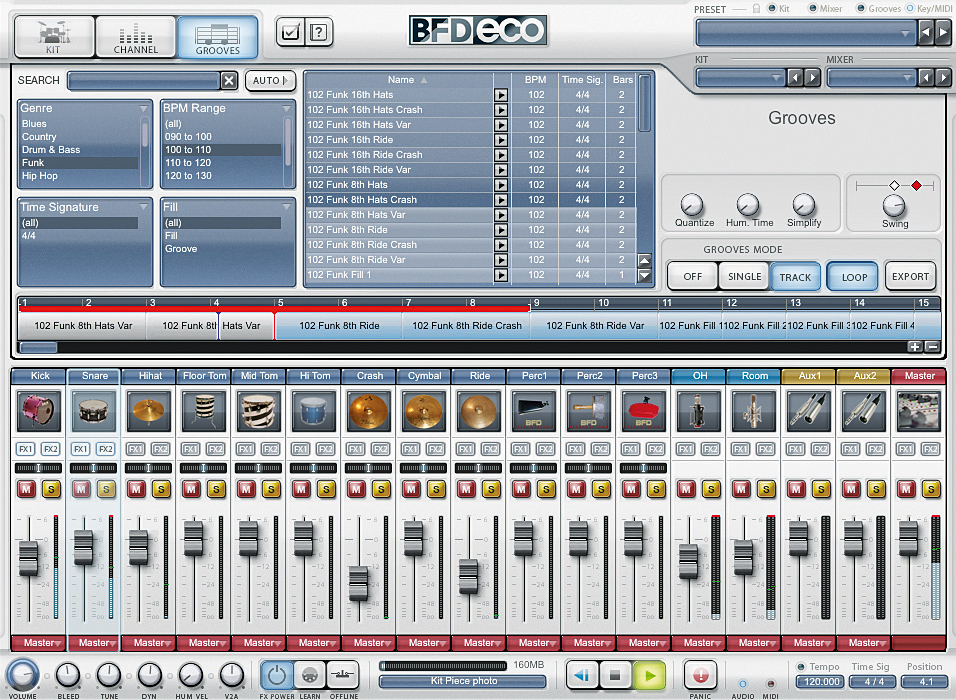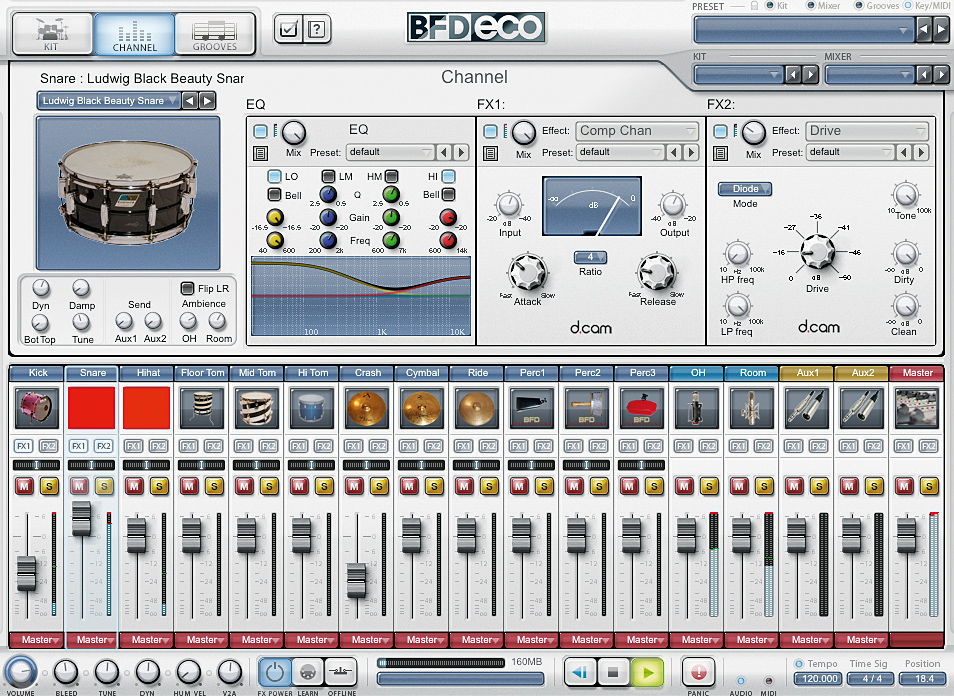MusicRadar Verdict
Eco offers a sensible combination of ease of use and flexibility, all with BFD's famously good sound.
Pros
- +
Easy kit, mixer and channel presets. Excellent split-screen interface. Expandable through BFD add-ons. Usable groove presets. Competitive price.
Cons
- -
Auditioning not ideal. Occasionally inconsistent round robin.
MusicRadar's got your back
If you're serious about in-the-box drum production, virtual instruments such as FXpansion's BFD2 and Toontrack's Superior Drummer 2.0 deliver the goods. But for many of us, their complexity and large hard drive footprint can be a turn-off.
With this in mind, FXpansion has taken some of the best parts of BFD2 and moulded them into a simmered down, more affordable package: BFD Eco.
In this case, Eco means economy, so you get fewer drums, cymbals and features, and the quality of the library has been reduced to 16-bit. This results in a compact 5GB drive footprint. However, you're still looking at a 12-piece setup consisting of kick, snare, hi-hat, three toms, three cymbals and three percussion elements. With up to 24 velocity layers per piece, realism and playability haven't been forsaken.
In detail
BFD Eco uses the same playback engine as BFD2, but with a stripped-back interface, comprising the mixer in the lower half and one of three selectable displays at the top. The Kit view shows a drum set graphic where clicking on pieces gives a fixed-velocity audition. The Channel display covers each mixer channel's settings, including built-in effects (EQ and two others of your choice) and further options via an inspector panel.
Inspector settings are available for all channels (except auxiliary and master) and include tuning, send levels (two auxiliaries, ambience and overhead), damping and various piece-specific options such as top/bottom balance for the snare, in/out balance for the kick and width/distance for the ambience channels.
"BFD Eco uses the same playback engine as BFD2, but with a stripped-back interface."
Eco's Grooves page combines a MIDI groove browser, with a simple single-track drum sequencer. Like most drum instruments, you can use this to choose grooves from the library, then drag-and-drop them as MIDI data into your host. Alternatively, you can add grooves to the built-in drum track, creating a preset-based sequence within Eco. Note that when doing this, you can't modify the MIDI on a note-by-note basis, although you can trim, drag, copy and paste the patterns.
Want all the hottest music and gear news, reviews, deals, features and more, direct to your inbox? Sign up here.

Finally, it's possible to select a single groove in the browser and have Eco play it in sync with your host (single mode), and this is good if you fancy spinning through some patterns with your DAW track playing.
So far, so good, but beyond this, you also get four 'groove effects': Quantize, Humanize, Simplify and Swing. These enable you to quickly adjust the grooves, and if you drag-and-drop the effected grooves into your host, the MIDI data is modified accordingly. We found this great for quickly piecing together variations on drum parts.
One slight annoyance is that Eco's tempo always syncs to the host, which means you can't audition grooves in the browser at their original tempo without continually tinkering with the host tempo setting.
As mentioned, the 17-channel mixer is always available at the bottom and there are 14 effects at hand, covering standard stuff like dynamics, reverbs (including a Breverb-based one courtesy of Overloud) and filters, as well as some that are less typical for a drum kit, such as flanging and bitcrushing.

As expected, some of BFD2's more advanced features are omitted - layering of kit pieces and sample import, for example. There are also a few other less immediately apparent changes: you don't get the second set of ambient mics; the bleed option is limited to one global control that adjusts kick bleed into the snare channel; and the library includes no hits played with brushes or rods. However, Eco is compatible with all of the BFD expansions, the only restrictions being the 24-velocity-layer limit and 16-bit rather than 24-bit resolution.
In use
Eco includes five kicks, six snares, 12 toms, three hi-hats, 11 cymbals and six percussion sounds, all sourced from the main BFD2 library, and all excellent - the Slingerland snare and the Pearl Masterworks kick are particular highlights. With 11 hi-hat articulations and five snare articulations, you can produce very convincing drum parts. And with plenty of processing options built in, you can do a lot of the basic mixing tasks, such as EQ and compression, within Eco's interface.
Where Eco really scores points is with its style-labelled preset system. This enables you to load a complete style-specific preset (ie, kit and mixer settings), but you can also load just the kit or just the mixer settings, or even just one kit piece complete with its channel settings and plug-ins. You can thus build or modify kits by quickly loading sounds complete with ready-to-go processing. Once you're done, you can then save your custom kit as a preset.
"Where Eco really scores points is with its style-labelled preset system."
Moving on from this, you get a bunch of 'artist' presets, many of which include a ready-allocated groove track. Once again, it's all about quick, easy results.
So, are there any downsides? First up, we found the fixed-velocity auditioning using the main kit graphic to be less than satisfactory. You can Alt-click the small channel icon for variable velocity previewing, but this is fiddly - the larger graphic is surely better suited to it. By default, BFD Eco's 'anti-machine gun' mode is disabled, so repeatedly playing the same hits can sound robotic. Enabling the mode randomises the velocity layers used, but we found the results too inconsistent at times, sounding as if accents were being added.
To be fair, EZdrummer's stock library suffers from similar issues, but it's a shame the feature can't be enabled per kit piece, to give, say, a rock solid kick drum, but more liveliness elsewhere.
Finally, it has to be said that you may find yourself wanting more choice, which means paying for expansion packs, so bear this in mind when weighing up the price. Even so, you get more kit pieces than Eco's main rival, EZdrummer, not to mention those tweakable built-in effects.
Summary
BFD Eco's interface won us over, with the split screen design making it easier to use than BFD2. In a similar vein, the simple drum track system sidesteps the complexities of BFD2's grid-style groove programmer.
All in all, BFD Eco is a surprisingly powerful drum instrument given its price point, and is backed up by a great add-on library, but power users will still prefer the more option-rich BFD2.
Take a listen to BFD Eco in action:
1. Shuffle rock part: Combining a slow rock beat gradually, increasing first quantize, then humanize then simplify to show how they affect the groove
2. Kit pieces: Using a simple pattern, spinning through first the kicks (Pork Pie, DW, Gretsch, Ludwig Vistalite and Pearl Masterworks), then snares (Slingerland, Bleifuss, DW, Ludwig Supraphonic, Black Beauty and Pearl Masterworks Piccolo) and hats (Zildjian Mastersound, Zildjian Custom Dark, Paiste Sound Edge)
3. Artist preset in swing style
Computer Music magazine is the world’s best selling publication dedicated solely to making great music with your Mac or PC computer. Each issue it brings its lucky readers the best in cutting-edge tutorials, need-to-know, expert software reviews and even all the tools you actually need to make great music today, courtesy of our legendary CM Plugin Suite.

